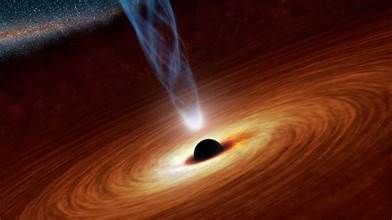Black holes have long fascinated both scientists and the public, remaining one of the most mysterious and intriguing phenomena in the universe. Despite their ominous name, black holes are not holes at all, but incredibly dense regions in space where gravity is so strong that nothing, not even light, can escape. Their discovery and subsequent study have led to profound insights into the nature of gravity, time, and space itself. However, many questions remain unanswered, leaving scientists with an ongoing challenge to unlock the secrets hidden within these cosmic giants.
What Exactly is a Black Hole?
A black hole is formed when a massive star collapses under its own gravitational pull at the end of its life cycle. This collapse compresses the star’s mass into a very small, infinitely dense point called a singularity. The point of no return around a black hole is called the event horizon; once something crosses this boundary, it is forever trapped by the black hole’s gravity. The strength of a black hole’s gravity is so immense that it warps the fabric of space and time, a phenomenon predicted by Albert Einstein’s theory of general relativity.
The event horizon is often thought of as a “point of no escape” because anything that passes it is drawn toward the singularity. This concept challenges our understanding of physics, as conventional laws break down under the extreme conditions of a black hole.
The Role of Gravity in Black Holes
The immense gravity of a black hole is responsible for its powerful ability to attract matter and energy. This gravitational pull is the result of the incredible density and mass concentrated in such a small area. Einstein’s theory of general relativity describes gravity as the warping of space-time caused by mass. When a star’s mass collapses into a black hole, it causes a distortion in space-time that becomes extreme around the event horizon.
This extreme warping of space-time can have fascinating effects on nearby objects. For example, light passing near a black hole can be bent due to the gravitational lensing effect, allowing astronomers to observe distant objects in the universe that would otherwise be hidden. It is this bending of light that first provided indirect evidence of black holes’ existence.
Hawking Radiation and the Thermodynamics of Black Holes
One of the most groundbreaking discoveries related to black holes was proposed by physicist Stephen Hawking in 1974. According to Hawking, black holes are not completely black but emit a faint radiation due to quantum effects near the event horizon. This phenomenon, known as Hawking radiation, suggests that black holes can slowly lose mass and energy over time.
Hawking’s prediction was revolutionary because it showed that black holes could potentially shrink and evaporate, a process that challenges the classical notion that nothing could escape a black hole once it crossed the event horizon. If this theory holds, it means black holes could eventually disappear, although the time scale for this process is mind-bogglingly long, potentially taking longer than the current age of the universe.
The Mystery of Black Hole Interiors
While we have a pretty good understanding of black holes’ outer characteristics, the interior of a black hole remains one of the greatest mysteries of modern physics. The singularity at the center of a black hole represents a point where the laws of physics as we know them break down. Here, the curvature of space-time becomes infinite, and densities are believed to approach infinity, creating conditions where current theories of physics fail to make accurate predictions.
One of the greatest challenges for scientists is reconciling general relativity, which explains the behavior of large-scale objects like black holes, with quantum mechanics, which governs the behavior of particles at the smallest scales. These two theories are not currently compatible, and understanding the true nature of black holes may require a theory of quantum gravity, which remains elusive.
Observing Black Holes: A Modern Challenge
While black holes cannot be directly observed, their presence can be inferred through the effects they have on nearby objects. Astronomers detect black holes by observing how they influence the motion of nearby stars or gas clouds, or by detecting high-energy radiation emitted as matter is pulled into the black hole. In 2019, the Event Horizon Telescope made history by capturing the first-ever image of a black hole’s event horizon in the galaxy M87, providing the world with visual evidence of their existence.
These observations have helped deepen our understanding of black holes, but much of their inner workings remain a mystery. Continued advancements in telescope technology, such as the James Webb Space Telescope, promise to provide more detailed data in the future, possibly unlocking more secrets about these enigmatic objects.
Black Holes and Their Impact on Popular Culture
Black holes have not only captivated the scientific community but have also become a staple in popular culture. Movies, books, and television shows often explore the mysteries of black holes, portraying them as gateways to alternate dimensions or as harbingers of cosmic doom. However, while these portrayals are often speculative and fantastical, they spark interest in the science behind black holes.
As we approach the holiday season, one might find interesting books or documentaries about black holes as Christmas gifts, allowing science enthusiasts to dive deeper into these cosmic wonders.
Conclusion
The science of black holes has transformed our understanding of the universe. While many mysteries remain unsolved, each new discovery brings us closer to understanding the role these cosmic giants play in the broader context of space and time. From the formation of black holes to the possibility of Hawking radiation, these enigmatic objects continue to challenge our understanding of physics. With ongoing research and technological advancements, the mysteries of black holes may one day be fully unraveled, providing answers to some of the most profound questions about the universe itself.





